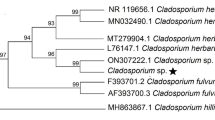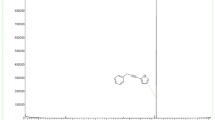Abstract
Sphaeranthus indicus, Cleistanthus collinus and Murraya koenigii leaf extracts were tested against the third instar larvae of Culex quinquefasciatus. The plant material was shade dried at room temperature and powdered coarsely. From each plant, 500 g powder was macerated with 1.5 L of hexane, chloroform and ethyl acetate sequentially for a period of 72 h each and filtered. The yield of the S. indicus, C. collinus and M. koenigii crude extracts by hexane, chloroform and ethyl acetate was 9.16, 11.71 and 10.83 g for S. indicus; 8.17, 10.69 and 9.85 g for C. collinus; and 10.11, 11.92 and 9.87 g for M. koenigii, respectively. The extracts were concentrated at reduced temperature on a rotary vacuum evaporator and stored at a temperature of 4°C. The S. indicus, C. collinus and M. koenigii leaf extracts at 250, 500, 750 and 1,000 ppm caused a significant mortality of C. quinquefasciatus. The LC50 and LC90 values of S. indicus, C. collinus and M. koenigii against third instar larvae at 24, 48 and 72 h (hexane, chloroform and ethyl acetate) were the following: S. indicus LC50 values were 544.93, 377.86 and 274.79 ppm and LC90 values were 1,325.32, 1,572.55 and 1,081.29 ppm at 24 h; C. collinus LC50 values were 375.34, 318.29 and 226.10 ppm and LC90 values were 699.65, 1,577.62 and 1,024.92 ppm at 24 h; and M. koenigii LC50 values were 963.53, 924.85 and 857.62 ppm and LC90 values were 1,665.12, 1,624.68 and 1,564.37 ppm at 24 h, respectively. However, the highest larval mortality was observed in C. collinus followed by S. indicus and M. koenigii of various concentrations at 24, 48 and 72 h. The study proved that S. indicus, C. collinus and M. koenigii leaf extracts had larvicidal property against species of C. quinquefasciatus. This is an ideal ecofriendly approach for the control of vector control programmes.






Similar content being viewed by others
References
Abdul Rahuman A, Venkatesan P, Gopalakrishnan G (2008) Mosquito larvicidal activity of oleic and linoleic acids isolated from Citrullus colocynthis (Linn.) Schrad. Parasitol Res 103:1383–1390
Amer A, Mehlhorn H (2006a) Larvicidal effects of various essential oils against Aedes, Anopheles, and Culex larvae (Diptera, Culicidae). Parasitol Res 99:466–472
Amer A, Mehlhorn H (2006b) Repellency effect of forty-one essential oils against Aedes, Anopheles, and Culex mosquitoes. Parasitol Res 99:478–490
Anonymous (1962) The wealth of India: the raw materials. Vol VI, India, CSIR, pp 446-48
Arivoli S, Samuel T (2011) Studies on the mosquitocidal activity of Murraya koenigii (L.) Spreng (Rutaceae) leaf extracts against Aedes aegypti, Anopheles stephensi and Culex quinquefasciatus (Diptera: Culicidae). Asian J Expl Biol Sci2(4): 721-730
Baslas KK (1959) Essential oil from Sphaeranthus indicus Perf. J Essent Oil Res 50:765
Basu NK, Lamsal PP (1946) Chemical investigation of Sphaeranthus indicus Linn. J Am Pharm Asso 35:274–5
Bernhard L, Bernhard P, Magnussen P (2003) Management of patients with lymphoedema caused by filariasis in north-eastern Tanzania: alternative approaches. Physiotherapy 89:743–749
Bhakuni DS, Dhar MM, Dhawan BN, Mehrota BN (1969) Screening of Indian plants for biological activity. Ind J Exp Biol 7:250–253
Brandis D, Singh B, Singh M, Dun D (1972) Indian trees and account of trees, shrubs and woody climbers, bamboos and palms indigenous or commonly cultivated in British Indian empire, 5th edn. Bishen Singh. Mahendrapal Singh, Dehradun, pp 113–114
Chandre F, Darriet F et al (1998) Pyrethroid resitance in Culex quinquefasciatus from West Africa. Med Vet Entomol 12:359–366
Chavan SR, Nickam SL (1982) Mosquito larvicidal activity of Ocimum basilium (Linn.). Ind J Med Res 75:220–222
Desai ST (2002) Potency of larvicidal properties of plant extracts against mosquito larvae under laboratory conditions (M.Sc. Dissertation submitted to Mumbai University Mumbai, India)
Deshmukh PB, Chavan SR, Renapurkar DM (1982) A study of insecticidal activity of twenty indigenous plants. Pesticides 12:7–10
Eswarappa S, Benjamin SPE (2007) Renal failure and neuromuscular weakness in Cleistanthus collinus poisoning. J Assoc Phy India 55:85–86
Eswarappa S, Chakraborty AR, Palatty BU (2003) Cleistanthus collinus poisoning: case report and review of the literature. J Toxicol 41:369–372
Finney DJ (1971) Probit analysis. Cambridge University Press, London, pp 68–78
Gogate MG, Ananthasubramanian L, Nargund KS, Bhattacharyya SC (1986) Some interesting sesquiterpinoids from Sphaeranthus indicus Linn. (Compositae). Indian J Chem 25B:233–238
Gogate VM (2000) Ayurvedic pharmacology and therapeutic uses of medicinal plants (Dravyaganvigyan), 1st edn. Bharatiya Vidya Bhavan, Mumbai
Govindachari TR, Sathe SS, Viswanathan N (1969) Chemical constituents of Cleistanthus collinus (Rox.). Tetrahedron 25:2815–2821
Govindarajan M, Jebanesan A, Pushpanathan T (2008) Larvicidal and ovicidal activity of Cassia fistula Linn. leaf extract against filarial and malarial vector mosquitoes. Parasitol Res 102(2):289–292
Green MM, Singer JM et al (1981) Larvicidal activity of Tagetes minuta (marigold) towards Aedes aegypti. J Am Mosq Control Assoc 7:282–286
Gupta RK, Chandra S, Mahandevan V (1967) Chemical composition of Sphaeranthus indicus Linn. Ind J Pharmocol 29:47–8
Gupta NS (1984) The Ayurvedic system of medicine. Vol. II. New Delhi: Logas Press
Harve G, Kamath V (2004) Larvicidal activity of plant extracts used alone and in combination with known synthetic larvicidal agents against Aedes aegypti. Ind J Exp Biol 42(12):1216–1219
Hiremath SM, Madalageri BB, Basarkar PW (1998) Composition of curry leaf (Murraya koenigii preng) oil during leaf growth. Indian Perfum 42:58–59
Jasim Uddin Chowdhury, Md. Nazrul Islam Bhuiyan, Mohammed Yusuf (2008) Chemical composition of the leaf essential oils of Murraya koenigii (L.) Spreng and Murraya paniculata (L.) Jack. J Bangladesh Pharmacol Soc (BDPS) 3:59–63
Jayaraman M, Govindaswamy S (2000) Cleistanthin A, a diphyllin glycoside from Cleistanthus collinus, is cytotoxic to PHA-stimulated (proliferating) human lymphocytes. Drug Dev Res 51:187–190
Kirthikar KR, Basu BD (1935) Indian medicinal plants, 2nd edn. Lalit Mohan Basu, New Delhi, pp 474–475
Kirtikar KR, Basu BD (1987) Indian medicinal plants, 2nd edn. International Book Distributors, Dehradun
Kovendan K, Murugan K (2011) Effect of medicinal plants on the mosquito vectors from the different agro-climatic regions of Tamil Nadu, India. Adv Environ Biol 5(2):335–344
Kovendan K, Murugan K, Thiyagarajan P, Kumar N, Abirami D, Asaikkutti A (2009) Impact of climate change on the filarial vector, Culex quinquefasciatus Say (Diptera: Culicidae). In: International congress of global warming on biodiversity of insects: management and conservation, 9–12 February 2009. Tamil Nadu, India, p 62
Kovendan K, Murugan K, Vincent S, Kamalakannan S (2011a) Larvicidal efficacy of Jatropha curcas and bacterial insecticide, Bacillus thuringiensis, against lymphatic filarial vector, Culex quinquefasciatus Say. (Diptera: Culicidae). Parasitol Res 109:1251–1257
Kovendan K, Murugan K, Panneerselvam C, Mahesh Kumar P, Amerasan D, Subramaniam J, Vincent S, Barnard DR (2011b) Laboratory and field evaluation of medicinal plant extracts against filarial vector, Culex quinquefasciatus Say (Diptera: Culicidae). Parasitol Res. doi:10.1007/s00436-011-2736-2
Kovendan K, Murugan K, Vincent S, Barnard DR (2012a) Studies on larvicidal and pupicidal activity of Leucas aspera Willd. (Lamiaceae) and bacterial insecticide, Bacillus sphaericus, against malarial vector, Anopheles stephensi Liston. (Diptera: Culicidae). Parasitol Res 110:195–203
Kovendan K, Murugan K, Vincent S (2012b) Evaluation of larvicidal activity of Acalypha alnifolia Klein ex Willd. (Euphorbiaceae) leaf extract against the malarial vector, Anopheles stephensi, dengue vector, Aedes aegypti and Bancroftian filariasis vector, Culex quinquefasciatus (Diptera: Culicidae). Parasitol Res 110:571–581
Kovendan K, Murugan K, Naresh Kumar A, Vincent S, Hwang JS (2012c) Bioefficacy of larvicdial and pupicidal properties of Carica papaya (Caricaceae) leaf extract and bacterial insecticide, spinosad, against chikungunya vector, Aedes aegypti (Diptera: Culicidae). Parasitol Res 110(110):669–678
Kovendan K, Murugan K, Prasanna Kumar K, Panneerselvam C, Mahesh Kumar P, Amerasan D, Subramaniam J, Vincent S (2012d) Mosquitocidal properties of Calotropis gigantea (Family: Asclepiadaceae) leaf extract and bacterial insecticide, Bacillus thuringiensis, against the mosquito vectors. Parasitol Res. doi:10.1007/s00436-012-2865-2
Lakshmi TG, Srimannarayan G, Subba rao NV (1970) A new glucoside from Cleistanthus collinus. Curr Sci 5:17
Latha C, Vijayakumar PD, Velayutham S, Joseph A (1999) Biological activity of indigenous plant extracts as mosquito larvicides. Ind J Exp Biol 37:206–208
Mahesh Kumar P, Murugan K, Kovendan K, Subramaniam J, Amaresan D (2012) Mosquito larvicidal and pupicidal efficacy of Solanum xanthocarpum (Family: Solanaceae) leaf extract and bacterial insecticide, Bacillus thuringiensis, against Culex quinquefasciatus Say (Diptera: Culicidae). Parasitol Res. doi:10.1007/s00436-011-2797-2
Maheswaran R, Sathis S, Ignacimuthu S (2008) Larvicidal activity of Leucus aspera (Willd.) against the larvae of Culex quinquefasciatus Say. and Aedes aegypti L. Int J Int Biol 2(3):214–217
Michael E, Bundy DA, Grenfell BT (1996) Re-assessing the global prevalence and distribution of lymphatic filariasis. Parasitol 112:409–428
National Institute of Communicable Diseases (1990) Proceedings of the national seminar on operation research on vector control in filariasis. New Delhi
Nisha M, Kalyanasundaram M, Paily KP, Abidha VP, Balaraman K (2007) In vitro screening of medicinal plant extracts for macrofilaricidal activity. Parasitol Res 100(3):575–579
Paranjape P (2001) Indian medicinal plants. In: Forgotten healer: a guide to ayurvedic herbalmedicine. Chaukhamba Sanskrit Pratishthan, Delhi, p 148-9
Raina VK, Lal RK, Tripathi S, Khan M, Syamasundar KV, Srivastava SK (2002) Essential oil composition of genetically diverse stocks of Murraya koenigii from India. Flav Frag J 17:144–46
Ramaiah KD, Das PK, Appavoo NC, Ramu K, Augustin DJ, Kumar KN, Chandrakala AV (2000) A programme to eliminate lymphatic filariasis in Tamil Nadu state, India: compliance with annual single-dose DEC mass treatment and some related operational aspects. Trop Med Int Health 5:842–847
Ranson H, Rossiter L, Ortelli F, Jensen B, Wang XL et al (2001) Identification of a novel class of insect glutathione S-transferases involved in resistance to DDT in the malaria vector Anopheles gambiae. Biochem J 359:295–304
Rawani A, Haldar KM, Ghosh A, Chandra G (2009) Larvicidal activities of three plants against filarial vector Culex quinquefasciatus Say (Diptera: Culicidae). Parasitol Res 105:1411–1417
Rehel S (2011) Sphaeranthus indicus. In: IUCN 2011. IUCN Red List of Threatened Species. Version 2011.2. www.iucnredlist.org
Sarathchandra G, Balakrishnamoorthy P (1998) Acute toxicity of Cleistanthus collinus, an indigenous poisonous plant in Cavia porcellus. J Environ Biol 1:145–148
Sastri BN (1952) The wealth of India, a dictionary of Indian raw material and industrial products. New Delhi, Council of Scientific and Industrial Research, pp 446–447
Sharma M, Saxena RC (1996a) Sphaeranthus indicus as a mosquito larvicidae. J Applied Zool Res 7(1):87–88
Sharma M, Saxena RC (1996b) Sphaeranthus indicus as a mosquito larvicidae. J Appl Zool Res 7(1):87–88
Shekhani MS, Shah PM, Yasmin A, Siddiqui R, Perveen S, Khan KM (1990) An immunostimulant sesquiterpene glycoside from Sphaeranthus indicus. Phytochem 29:2573–6
Sukari MA, Ahmad K, Haron Md Jelas, Muse R (2001) Carbazole alkaloids from roots of Murraya Koenigii (Rutaceae). Malaysian J Analytical Sci 7:1263–265
Venketachalam MR, Jebanesan A (2001) Larvicidal activity of Hydrocotyl javanica Thumb (Apiaceae) extract against Culex quinquefasciatus. Ind J Exp Zool 4(1):99–101
Walde GS, Joythirmay T, Rao PGP, Shivaswamy R, Srinivas P (2005) Flavour volatiles of leaves, fruits and seed cotyledons of Murraya koenigii L. Flav Frag J 20:169–72
WHO (1992) Lymphatic filariasis: the disease and its control. 5th report of the WHO Expert Committee on Filariasis. Technical Report Series. p 821
World Conservation Monitoring Centre (1998) Cleistanthus collinus. In: IUCN 2011. IUCN Red List of Threatened Species. Version 2011.2. www.iucnredlist.org.
Yadav RN, Kumar S (1998) 7-Hydroxy-3′,4'′,5,6-tetramethoxy flavone 7-O-b-D-(1-4)-diglucoside, a new flavone glycoside from the stem of Sphaeranthus indicus. J Roy Inst Chem 70:164–6
Zipcodezoo (2012) “Murraya koenigii”. In: Flora of China Vol. 11 Page 86, 87. Botanical Garden, Missouri. Online at EFloras.org
Acknowledgments
We thank Dr. T. Ambrose, Professor and Head of the Department of Advanced Zoology and Biotechnology, Loyola College, Chennai, Tamil Nadu, India, for the laboratory facilities provided and for his valuable suggestions and constant encouragement during the study period.
Author information
Authors and Affiliations
Corresponding author
Additional information
Kalimuthu Kovendan and Subramaniam Arivoli made equal contributions to this work.
Rights and permissions
About this article
Cite this article
Kovendan, K., Arivoli, S., Maheshwaran, R. et al. Larvicidal efficacy of Sphaeranthus indicus, Cleistanthus collinus and Murraya koenigii leaf extracts against filarial vector, Culex quinquefasciatus Say (Diptera: Culicidae). Parasitol Res 111, 1025–1035 (2012). https://doi.org/10.1007/s00436-012-2927-5
Received:
Accepted:
Published:
Issue Date:
DOI: https://doi.org/10.1007/s00436-012-2927-5




